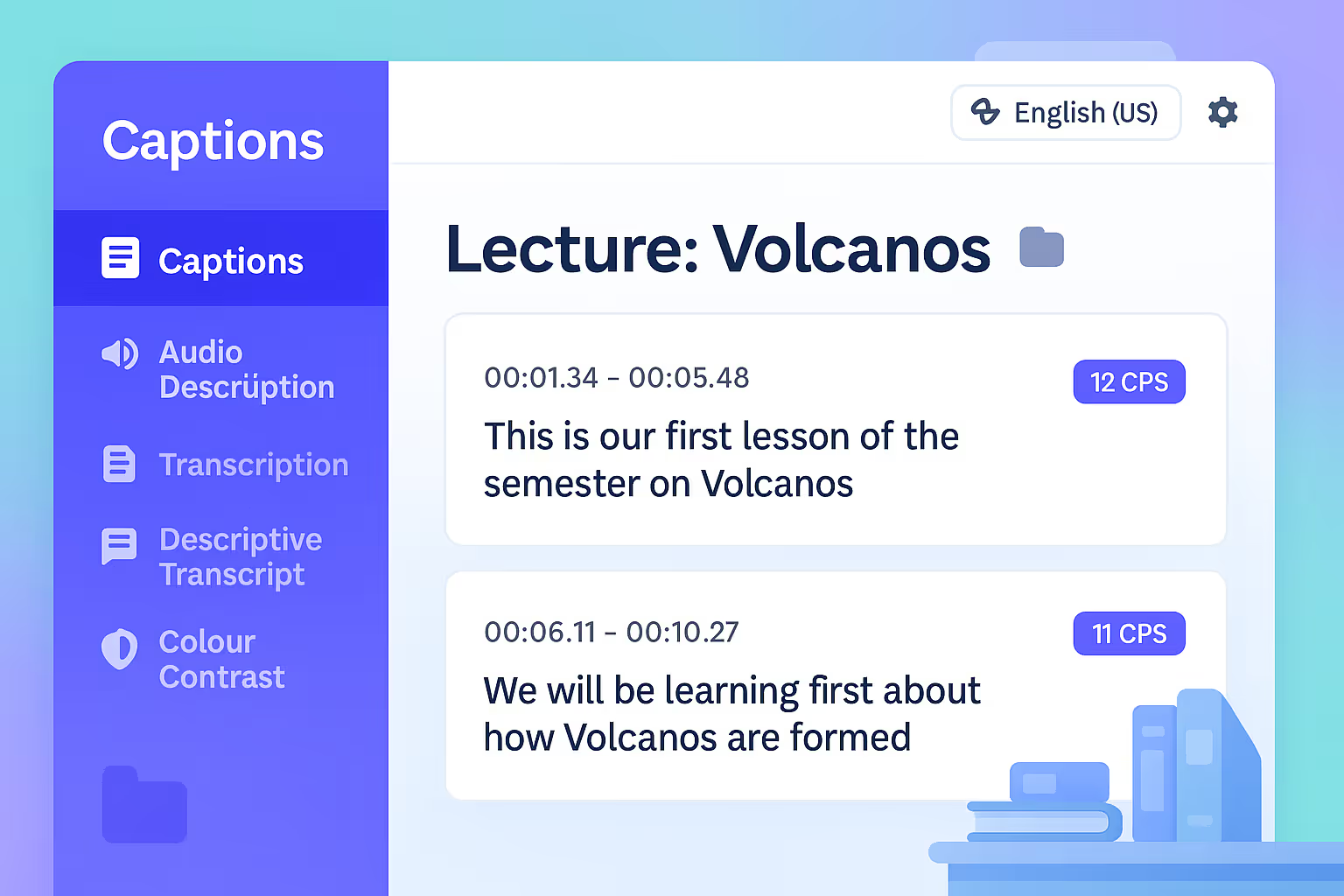See How Subly Works.
Take a Tour
Ensure every video, lecture, and online course meets ADA Title II’s accessibility requirements.
Discover what the new ADA Title II rule means for your videos and courses.
See Subly in action — captions, descriptive transcripts, audio descriptions, and more.
Leave with clear next steps to meet the April 2026 deadline.

Public schools, colleges, and universities must make all video, audio, and e-learning content accessible under the U.S. Department of Justice’s updated ADA Title II rule — enforceable from April 2026.
Required for all speech and key sounds.
Text and visuals must meet readability standards.
Narrate essential visual elements where relevant.
Describe key visuals like charts or diagrams not covered in audio.
Provide a text alternative for audio-only content.
Required for videos without dialogue or key visual information.
Limit flashing to protect users with epilepsy.
Correct language tags so assistive technology reads content properly.
Subly’s platform lets you check and fix your media to make it fully accessible, compliant, and scalable — all in one place.
If your institution publishes video-based learning, promotional videos, or virtual events — they must all meet accessibility standards by April 2026.
Institutions operated or funded by state or local governments.
Entities offering online learning, training, or information to the public.
Companies producing videos, courses, or digital media on behalf of public institutions.
Learn the requirements and check your media accessibility — all from Subly.


Automatically finds every accessibility issue and shows you exactly where to fix it.
We've got answers! Browse through our FAQ section to find quick solutions and detailed explanations to some of the most common queries. Whether you're just getting started or need specific guidance, our comprehensive FAQs are here to assist you every step of the way.
Request a callIn April 2024, the U.S. Department of Justice (DOJ) published a final rule updating ADA Title II, requiring all state and local government entities, including public schools, colleges, and universities, to make their digital content accessible.
Institutions must comply by April 24, 2026 (or April 2027 for smaller jurisdictions). The rule mandates conformance with WCAG 2.1 Level AA accessibility standards.
The rule applies to all state and local government agencies and public education institutions. This includes K–12 schools, community colleges, public universities, and any contractors or vendors that create digital or media content for these entities.
ADA Title II covers all public-facing digital content, including:
• Websites and online portals
• Mobile applications
• Digital learning tools and e-courses
• Video and audio materials
• Media hosted on third-party platforms if produced or shared by the institution
Under ADA Title II, all video, audio, and e-learning materials shared by public institutions must be perceivable, operable, and understandable in line with WCAG 2.1 Level AA. This means:
• Captions for all spoken dialogue and important sounds.
• Transcripts for audio-only content.
• Audio descriptions or descriptive transcripts for visual details not conveyed in audio.
• Accessible media players that can be used with a keyboard or assistive technology.
• Readable text and contrast, and control over flashing or autoplaying content.
• Non-compliance can lead to accessibility complaints and enforcement under ADA Title II.
ADA Title II adopts WCAG 2.1 Level AA as its accessibility standard. For pre-recorded media, institutions must include captions (1.2.2), transcripts for audio-only content (1.2.1), and audio descriptions or descriptive transcripts for key visual details (1.2.3 / 1.2.5).
Text and captions must meet contrast requirements (1.4.3), avoid flashing content (2.3.1), and use correct language tags (3.1.1) to ensure accessibility by April 2026.
• April 24, 2026: Entities with populations over 50,000
• April 24, 2027: Entities with smaller populations
• Institutions are encouraged to begin accessibility audits now to ensure compliance before the enforcement date.
Failure to comply may lead to DOJ enforcement actions, lawsuits, or loss of public trust. Beyond legal risk, inaccessible content excludes students, staff, and the public with disabilities from equal participation.
Institutions can use tools like Subly’s Accessibility Checker, which automatically assesses videos and audio files against WCAG 2.1 AA requirements. It identifies missing captions, transcripts, or audio descriptions and helps teams fix issues quickly.
Subly’s all-in-one platform combines an Accessibility Checker and Accessibility Editor to help institutions test and fix videos, audio, and other media against WCAG 2.1 AA. Subly makes it simple to add captions, transcripts, and audio descriptions — helping teams achieve ADA compliance efficiently and at scale.
No. The DOJ’s final rule references WCAG 2.1 Level AA as the required technical standard. However, WCAG 2.2 builds upon 2.1 and can be adopted voluntarily to future-proof compliance. Subly supports both frameworks for comprehensive accessibility coverage.
Begin with an accessibility audit of all video and audio materials. Subly can automatically check your media against WCAG 2.1 AA, highlight any gaps, and provide tools to fix them — helping your institution stay on track for the April 2026 deadline.